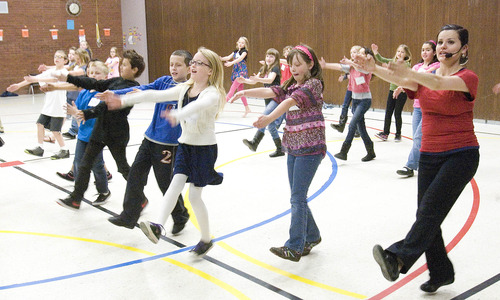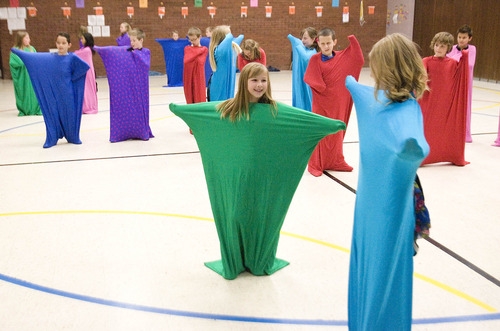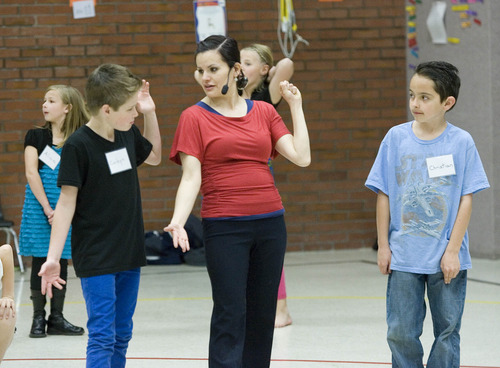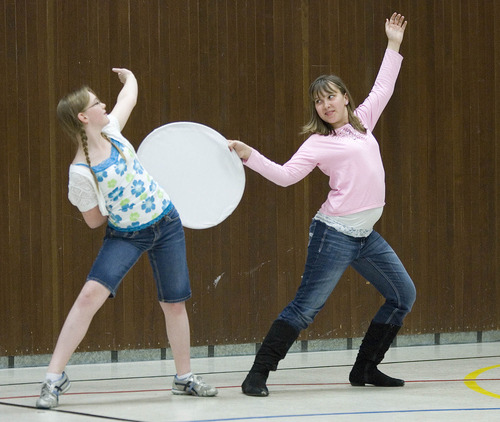This is an archived article that was published on sltrib.com in 2013, and information in the article may be outdated. It is provided only for personal research purposes and may not be reprinted.
Students are accustomed, in geometry lessons, to drawing, comparing and measuring shapes.
But on a recent day in Angela Challis' class at South Jordan's Welby Elementary School, fourth-graders became the shapes. They squeezed into red, pink, blue and purple costumes to demonstrate the meanings of congruent, not congruent and similar. The kids performed dances, twisting their bodies into poses, while singing definitions.
"You're learning it in more of a fun way rather than just paper and pencil," said fourth-grader Tyler Sim. "It's easier to remember because you're having a fun time."
The lesson was part of the Beverley Taylor Sorenson Arts Learning Program, which thanks to an additional $4 million from lawmakers this session, will soon expand. It's already in 75 Utah schools and will likely be in 130 next school year, or about one-fourth of all public elementaries in the state.
Here's how it works: Students take dance, visual art, music or drama classes during the school day, often about once every other week, from arts specialists who typically divide their time between two schools. The specialists also work with classroom teachers to use the arts to teach and reinforce academic concepts from regular lessons.
Schools that get the specialists must match some of the state dollars to pay for them.
The model was developed by Art Works for Kids and Sorenson, a former teacher, pianist and wife of the late biotechnology pioneer James LeVoy Sorenson.
Results seem promising. In 2012, the Utah Education Policy Center at the University of Utah found correlations between the Sorenson program and math achievement, especially in the schools that most faithfully implemented it. A February Utah Foundation report, commissioned by the program, also found some correlation between proficiency rates on state tests and the arts program, though the foundation noted that more research is needed before drawing conclusions.
Lisa Cluff, executive director of Friends of Art Works for Kids, said the program is a way for all kids to be successful regardless of their backgrounds and circumstances. Schools without it rarely have consistent arts programs, instead relying on classroom teachers, volunteers and district arts educators to expose kids to the arts, according to the Utah Foundation report.
"No matter what language they speak or where they're from, they can all participate in the arts," Cluff said. "This is a way they can express themselves and use their creativity."
She said she's "thrilled" lawmakers agreed to add $4 million to the program this year.
The cash was, after all, hardly a sure thing. During last year's session, lawmakers awarded it $2 million of the $4 million requested. Cluff said she was told lawmakers were concerned that the program wasn't reaching enough kids for its cost and that the price per student was too high. That's why organizers made the decision to split teachers' time between two schools this school year.
The change meant arts instruction for more kids, but, in many cases, half as often.
It's a model, however, that organizers plan to continue using. Cluff said next year the program will seek $5 million in hopes of continued expansion. The ultimate goal is to reach every elementary student in Utah.
All of the principals at schools with the program said they believed it had definitely or probably made a positive difference in their students' quality of education, according to a 2010 Dan Jones and Associates survey.
Joel Redmond, a fourth-grade teacher at Welby, said after a dance lesson earlier this year about clouds, it was "amazing" how many of his students started identifying different types of clouds when they walked outside.
"I think the trend has gone with elementary schools to test them to death, and I think we have to realize they're elementary students, not middle school or high school students," Redmond said.
Challis said she tries, in her dance classes, to engage kids who learn through sight, sound and/or movement.
"It lets them be kids," Challis said. "They need to play, they need to learn through play."
Shortly before her fourth-grade geometry lesson, Challis taught a class of sixth-graders a dance about the phases of the moon. They swung white discs to the lyrics of a rap song about the different phases, practicing first in the light and then performing in the dark, under black lights to make the discs glow.
"It kind of sticks in your head," said sixth-grader Gandon Ludwig, "instead of just sitting there and having someone tell you."
Twitter: @lschencker



















